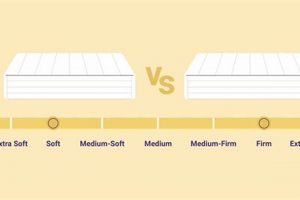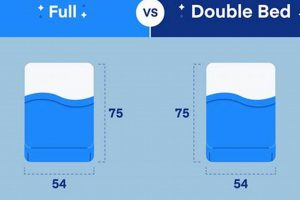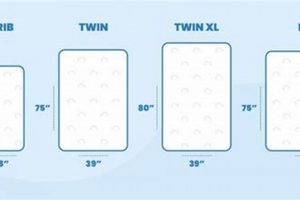The central comparison involves two common mattress dimensions offering distinct sleeping arrangements. One option provides a 60-inch width and 80-inch length, suitable for couples or single sleepers desiring more space. The other expands to a 76-inch width, maintaining the same 80-inch length, offering enhanced roominess, particularly advantageous for co-sleeping or individuals who prefer sprawling out.
Selecting the appropriate mattress size is crucial for optimizing sleep quality and overall bedroom functionality. A larger sleep surface can minimize sleep disturbances caused by partner movement, potentially leading to more restful nights. Historically, the development of varying mattress sizes reflects evolving consumer needs for comfort and space within the bedroom environment, moving beyond simple functionality towards personalized sleep solutions.
The subsequent discussion will delve into the specific advantages and disadvantages of each mattress size, examining factors such as room dimensions, budget considerations, and individual sleep preferences to facilitate an informed decision-making process when choosing the ideal sleep setup.
Considerations for Mattress Selection
The following outlines essential considerations when evaluating mattress options, focusing on dimensions, sleeping habits, and spatial limitations.
Tip 1: Evaluate Room Dimensions: Measure the intended bedroom space. Ensure adequate clearance around the mattress for movement and placement of other furniture. A too-large mattress will overcrowd the room, while a too-small one may appear disproportionate.
Tip 2: Assess Sleep Partner Needs: Account for the sleeping habits of all individuals sharing the mattress. Consider factors like tossing and turning, differing temperature preferences, and personal space requirements. A larger mattress can mitigate disturbances caused by restless sleepers.
Tip 3: Determine Budgetary Constraints: Establish a realistic budget. Larger mattresses typically incur higher costs, not only for the mattress itself but also for associated bedding and frames. Prioritize quality within the allocated financial resources.
Tip 4: Consider Sleep Style: Analyze your preferred sleeping position. Side sleepers might benefit from a mattress offering enhanced pressure relief, while back and stomach sleepers may require firmer support. The overall mattress dimensions should accommodate the chosen sleep style comfortably.
Tip 5: Factor in Future Needs: Anticipate potential changes in sleeping arrangements. If co-sleeping with children or pets is likely, a larger mattress may be a prudent investment. Consider the long-term value and adaptability of the mattress selection.
Tip 6: Research Mattress Types: Familiarize yourself with the various mattress types available, including innerspring, memory foam, latex, and hybrid models. Each type offers distinct characteristics in terms of support, comfort, and temperature regulation. Match the mattress type to individual preferences and needs.
Tip 7: Check Return Policies: Confirm the retailer’s return policy. Many companies offer trial periods, allowing consumers to test the mattress at home and return it if unsatisfied. Review the terms and conditions of the return policy prior to purchase.
Careful consideration of these factors will aid in selecting a mattress that optimizes sleep quality, enhances bedroom functionality, and aligns with individual needs and financial constraints.
The subsequent sections will explore the specific features and advantages of different mattress types to further assist in making an informed purchase decision.
1. Spatial requirements
Spatial requirements are a primary determinant in selecting between queen and king mattresses. The dimensions of the bedroom significantly dictate which size is appropriate to ensure comfortable movement and overall room functionality. A king mattress, wider than a queen, demands greater floor space. Overlooking this factor can result in a cramped and dysfunctional bedroom. For instance, a bedroom measuring 10 feet by 12 feet might accommodate a queen mattress comfortably, leaving adequate space for bedside tables and walking areas. Conversely, the same furniture placed alongside a king mattress could render the room congested and less usable.
The effect of insufficient spatial considerations extends beyond mere aesthetics. Limited space can impede movement within the room, posing a safety hazard. Furthermore, a crowded room can negatively impact sleep quality by creating a sense of confinement. Accurate measurement of the room and careful planning of furniture placement prior to purchasing a mattress is therefore essential. Consider the size and placement of existing furniture, such as dressers and nightstands, to ensure a cohesive and functional layout. This forethought prevents costly mistakes and ensures the selected mattress enhances, rather than detracts from, the bedroom environment.
In summary, understanding the spatial requirements associated with mattress dimensions is critical for achieving a balanced and functional bedroom design. Ignoring this aspect can lead to a compromised living space and negatively impact sleep quality. Prioritizing careful measurement and planning contributes to a more comfortable and aesthetically pleasing bedroom environment, aligning with the broader goal of optimizing both rest and daily living activities.
2. Partner sleeping habits
Shared sleeping arrangements necessitate considering each partner’s individual sleep habits when determining appropriate mattress dimensions. Discrepancies in sleep patterns, movement, and temperature preferences can significantly impact sleep quality for both individuals, thereby influencing the choice between a queen and a king mattress.
- Movement During Sleep
Significant differences in nocturnal movement, such as tossing and turning or restless leg syndrome, can disturb a partner’s sleep. A king mattress, with its greater width, provides increased separation and reduces the likelihood of these movements impacting the other sleeper. In contrast, a queen mattress may result in more frequent disturbances due to limited space.
- Temperature Preferences
Variations in preferred sleeping temperature can create discomfort. While mattress size does not directly address temperature, the increased surface area of a king mattress allows for greater airflow and less heat retention compared to a queen. This can indirectly improve comfort for individuals with differing thermal needs, allowing for separate bedding arrangements to manage individual preferences.
- Sleep Schedules
Differing sleep and wake times can disrupt sleep if one partner enters or exits the bed while the other is asleep. The added space of a king mattress minimizes the transfer of motion during these transitions, reducing the chances of waking the sleeping partner. A queen mattress offers less buffer, potentially leading to more frequent disturbances.
- Personal Space Needs
Individual requirements for personal space during sleep vary considerably. Some individuals prefer to sleep closer to their partner, while others require more physical distance for optimal comfort. A king mattress caters to those needing greater separation, allowing each person to maintain their preferred sleep posture and proximity to the edge of the bed without encroaching on the other’s space. A queen size offers reduced flexibility in this regard.
In summary, accommodating varying sleep habits is a critical factor when selecting mattress dimensions. While a queen mattress may suffice for couples with similar sleep patterns and minimal movement, a king mattress offers significant advantages in mitigating disturbances caused by differing sleep schedules, movements, and temperature preferences. Consideration of these factors ensures a more restful and comfortable sleep experience for both partners.
3. Budget implications
The budgetary implications associated with selecting a mattress represent a significant factor in the choice between a queen and a king size. The initial cost of the mattress itself typically increases with size, with king mattresses generally commanding a higher price point than their queen counterparts. This cost differential arises from the greater material usage in manufacturing and the logistical considerations involved in handling larger products. For example, a mid-range memory foam queen mattress might retail for $800, whereas a comparable king mattress could easily exceed $1200. This price difference can influence the purchase decision, particularly for budget-conscious consumers.
Beyond the mattress itself, ancillary costs further contribute to the overall financial impact. Bed frames, bedding (sheets, comforters, duvets), and mattress protectors all necessitate consideration, and these items typically exhibit a price premium for king-size dimensions. The increased fabric requirements for king-size bedding, for instance, often translate to a higher price tag. Furthermore, the larger size may necessitate upgraded delivery services or specialized moving equipment, adding to the expenses. For example, standard queen-size sheet sets might cost $50, while comparable king-size sets could range from $75 to $100 or more. Failure to account for these additional expenses can lead to unanticipated financial strain.
In summary, the budgetary implications of choosing between mattress sizes extend beyond the initial purchase price. The associated costs of frames, bedding, and potential delivery or moving expenses must be factored into the overall equation. Prioritizing a comprehensive assessment of all related costs ensures a financially responsible decision aligned with individual budgetary constraints. Ignoring these considerations can lead to overspending and ultimately detract from the long-term value and satisfaction derived from the chosen mattress.
4. Bedroom size
Bedroom dimensions directly influence the suitability of mattress size. The available space dictates whether a room can comfortably accommodate a queen or king mattress without compromising functionality and aesthetics.
- Floor Space and Circulation
Adequate floor space around the mattress is essential for ease of movement and prevents a cramped feel. A king mattress, due to its larger footprint, requires a correspondingly larger room to maintain comfortable circulation. For instance, a bedroom smaller than 10×10 feet might feel overcrowded with a king mattress, while a queen size would allow for more open space.
- Furniture Placement
Bedroom size dictates the placement and scale of other furniture items, such as bedside tables, dressers, and chairs. If a bedroom is too small, accommodating a king mattress may necessitate sacrificing or scaling down other essential furniture pieces. A queen mattress allows for greater flexibility in furniture arrangement within smaller spaces.
- Aesthetic Balance
The visual balance of a bedroom is affected by the proportion of the mattress to the room’s overall size. A king mattress in a small room can appear disproportionately large, overwhelming the space and creating an unbalanced aesthetic. A queen mattress, being smaller, tends to integrate more harmoniously into smaller rooms, preserving visual appeal.
- Doorways and Maneuverability
The physical dimensions of the mattress impact its maneuverability within the bedroom, particularly during initial setup or subsequent rearrangement. A king mattress can be challenging to navigate through narrow doorways or tight corners, potentially requiring disassembly or specialized handling. A queen mattress presents fewer logistical challenges due to its smaller size.
Ultimately, the bedroom’s dimensions serve as a critical constraint in selecting between mattress sizes. A comprehensive evaluation of floor space, furniture placement, aesthetic balance, and maneuverability ensures the chosen mattress enhances the room’s functionality and visual appeal without creating a sense of confinement or disproportion.
5. Individual sleep style
Individual sleep style, encompassing preferred sleeping position, movement during sleep, and personal space requirements, directly informs the optimal mattress size selection. Tailoring the mattress dimensions to accommodate these individualized preferences contributes significantly to sleep quality and overall comfort.
- Sleeping Position and Support
Preferred sleeping position influences the type of support required from a mattress. Side sleepers often benefit from a mattress with adequate give to relieve pressure on the shoulders and hips, while back sleepers typically require firmer support to maintain spinal alignment. The available space on a queen versus a king mattress can impact the degree to which these support needs are met, especially when sharing the bed. A king mattress allows for more individualized zones, potentially accommodating different support preferences across the sleep surface.
- Movement and Space Requirements
Individuals who tend to move frequently during sleep, whether through tossing and turning or stretching, require sufficient space to avoid disturbing their sleep partner. A king mattress provides considerably more room for such movements compared to a queen, minimizing the likelihood of disruptions. The added width allows for greater freedom of movement without encroaching on the partner’s personal space.
- Co-Sleeping Considerations
Families who engage in co-sleeping with children or pets require a larger sleep surface to comfortably accommodate all individuals. A king mattress is often the preferred choice in these situations, providing ample space for everyone to rest without feeling cramped. Queen mattresses may prove insufficient for accommodating multiple sleepers, leading to discomfort and compromised sleep quality.
- Edge Support Preference
Some individuals prefer to sleep near the edge of the bed, necessitating strong edge support to prevent roll-off and maintain a consistent sleep surface. The overall width of a king mattress, combined with robust edge support construction, offers a greater usable sleep area compared to a queen. This is particularly relevant for those who frequently utilize the full width of the mattress.
The connection between individual sleep style and mattress size highlights the importance of personalization in sleep solutions. While a queen mattress may suffice for single sleepers or couples with similar sleep habits and limited space, a king mattress offers considerable advantages in accommodating diverse sleeping positions, minimizing sleep disturbances, and providing ample space for co-sleeping arrangements. Consideration of these individualized factors ensures a more comfortable and restful sleep experience.
Frequently Asked Questions
The following addresses common inquiries and clarifies misconceptions surrounding mattress dimensions.
Question 1: Is a king mattress significantly larger than a queen?
Yes. A king mattress is 16 inches wider than a queen, offering substantially more sleeping surface area, particularly beneficial for couples who desire increased personal space.
Question 2: Does a larger mattress guarantee better sleep?
Not necessarily. While a larger mattress can mitigate sleep disturbances caused by partner movement, other factors such as mattress firmness, material composition, and individual sleep habits also play crucial roles in determining sleep quality.
Question 3: Are king-size bedding options more expensive than queen?
Generally, yes. King-size sheets, comforters, and other bedding accessories typically command a higher price due to the increased fabric and manufacturing costs associated with the larger dimensions.
Question 4: What bedroom size is recommended for a king mattress?
A minimum bedroom size of 12 feet by 12 feet is generally recommended to comfortably accommodate a king mattress, allowing for adequate space around the bed for movement and placement of other furniture.
Question 5: Can a king mattress fit through a standard doorway?
Depending on the doorway width, a king mattress may not fit without maneuvering or potential folding. Measuring the doorway and mattress dimensions is essential prior to attempting to move the mattress.
Question 6: Is a queen mattress suitable for co-sleeping with children?
While a queen mattress can accommodate co-sleeping, a king or even a California king mattress is generally preferred for families with multiple children, as the increased width provides a more comfortable and less congested sleep surface.
Selecting the optimal mattress size requires careful consideration of individual needs, spatial constraints, and budgetary limitations. There is no universally superior choice; the best option depends on specific circumstances.
The subsequent section will explore the distinctions between mattress types, further assisting in making an informed purchase decision.
Queen Mattress vs King Size
The preceding analysis has illuminated the critical distinctions between queen and king mattress dimensions, underscoring the multifaceted factors influencing optimal selection. Bedroom size, budgetary constraints, partner sleeping habits, and individual sleep styles each contribute significantly to the decision-making process. A queen mattress provides a space-conscious and often more economical solution, suitable for smaller rooms and single sleepers. Conversely, a king mattress offers enhanced personal space, minimizing sleep disturbances for couples and accommodating co-sleeping arrangements, albeit at a potentially higher cost and with greater spatial demands.
Ultimately, the determination between a queen mattress vs king size rests upon a meticulous evaluation of individual needs and environmental limitations. The informed consumer must weigh the advantages and disadvantages of each option, prioritizing those factors that most directly impact sleep quality and overall well-being. Careful consideration ensures a judicious investment that promotes restorative rest and long-term satisfaction.





![Leesa vs Casper Mattress: Which Bed is Best [2024]? Organic & Natural Mattress Buyer’s Guide: Non-Toxic Sleep Solutions Leesa vs Casper Mattress: Which Bed is Best [2024]? | Organic & Natural Mattress Buyer’s Guide: Non-Toxic Sleep Solutions](https://mattressworldpa.com/wp-content/uploads/2025/07/th-1078-300x200.jpg)

